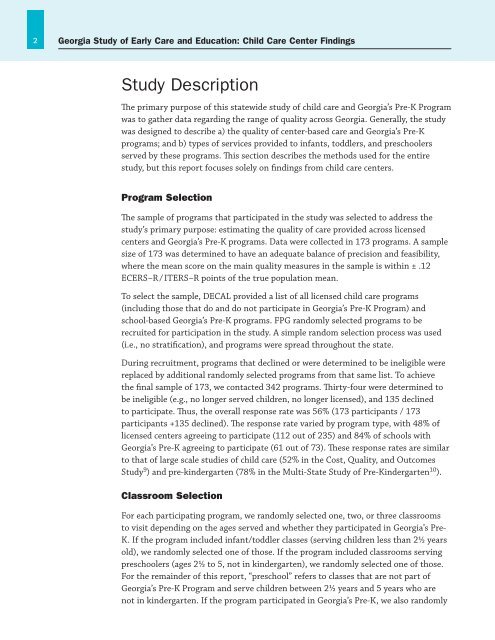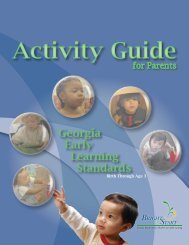Georgia Study of Early Care and Education: Child - Bright from the ...
Georgia Study of Early Care and Education: Child - Bright from the ...
Georgia Study of Early Care and Education: Child - Bright from the ...
You also want an ePaper? Increase the reach of your titles
YUMPU automatically turns print PDFs into web optimized ePapers that Google loves.
2 <strong>Georgia</strong> <strong>Study</strong> <strong>of</strong> <strong>Early</strong> <strong>Care</strong> <strong>and</strong> <strong>Education</strong>: <strong>Child</strong> <strong>Care</strong> Center Findings<br />
<strong>Study</strong> Description<br />
The primary purpose <strong>of</strong> this statewide study <strong>of</strong> child care <strong>and</strong> <strong>Georgia</strong>’s Pre-K Program<br />
was to ga<strong>the</strong>r data regarding <strong>the</strong> range <strong>of</strong> quality across <strong>Georgia</strong>. Generally, <strong>the</strong> study<br />
was designed to describe a) <strong>the</strong> quality <strong>of</strong> center-based care <strong>and</strong> <strong>Georgia</strong>’s Pre-K<br />
programs; <strong>and</strong> b) types <strong>of</strong> services provided to infants, toddlers, <strong>and</strong> preschoolers<br />
served by <strong>the</strong>se programs. This section describes <strong>the</strong> methods used for <strong>the</strong> entire<br />
study, but this report focuses solely on findings <strong>from</strong> child care centers.<br />
Program Selection<br />
The sample <strong>of</strong> programs that participated in <strong>the</strong> study was selected to address <strong>the</strong><br />
study’s primary purpose: estimating <strong>the</strong> quality <strong>of</strong> care provided across licensed<br />
centers <strong>and</strong> <strong>Georgia</strong>’s Pre-K programs. Data were collected in 173 programs. A sample<br />
size <strong>of</strong> 173 was determined to have an adequate balance <strong>of</strong> precision <strong>and</strong> feasibility,<br />
where <strong>the</strong> mean score on <strong>the</strong> main quality measures in <strong>the</strong> sample is within ± .12<br />
ECERS–R / ITERS–R points <strong>of</strong> <strong>the</strong> true population mean.<br />
To select <strong>the</strong> sample, DECAL provided a list <strong>of</strong> all licensed child care programs<br />
(including those that do <strong>and</strong> do not participate in <strong>Georgia</strong>’s Pre-K Program) <strong>and</strong><br />
school-based <strong>Georgia</strong>’s Pre-K programs. FPG r<strong>and</strong>omly selected programs to be<br />
recruited for participation in <strong>the</strong> study. A simple r<strong>and</strong>om selection process was used<br />
(i.e., no stratification), <strong>and</strong> programs were spread throughout <strong>the</strong> state.<br />
During recruitment, programs that declined or were determined to be ineligible were<br />
replaced by additional r<strong>and</strong>omly selected programs <strong>from</strong> that same list. To achieve<br />
<strong>the</strong> final sample <strong>of</strong> 173, we contacted 342 programs. Thirty-four were determined to<br />
be ineligible (e.g., no longer served children, no longer licensed), <strong>and</strong> 135 declined<br />
to participate. Thus, <strong>the</strong> overall response rate was 56% (173 participants / 173<br />
participants +135 declined). The response rate varied by program type, with 48% <strong>of</strong><br />
licensed centers agreeing to participate (112 out <strong>of</strong> 235) <strong>and</strong> 84% <strong>of</strong> schools with<br />
<strong>Georgia</strong>’s Pre-K agreeing to participate (61 out <strong>of</strong> 73). These response rates are similar<br />
to that <strong>of</strong> large scale studies <strong>of</strong> child care (52% in <strong>the</strong> Cost, Quality, <strong>and</strong> Outcomes<br />
<strong>Study</strong> 9 ) <strong>and</strong> pre-kindergarten (78% in <strong>the</strong> Multi-State <strong>Study</strong> <strong>of</strong> Pre-Kindergarten 10 ).<br />
Classroom Selection<br />
For each participating program, we r<strong>and</strong>omly selected one, two, or three classrooms<br />
to visit depending on <strong>the</strong> ages served <strong>and</strong> whe<strong>the</strong>r <strong>the</strong>y participated in <strong>Georgia</strong>’s Pre-<br />
K. If <strong>the</strong> program included infant/toddler classes (serving children less than 2½ years<br />
old), we r<strong>and</strong>omly selected one <strong>of</strong> those. If <strong>the</strong> program included classrooms serving<br />
preschoolers (ages 2½ to 5, not in kindergarten), we r<strong>and</strong>omly selected one <strong>of</strong> those.<br />
For <strong>the</strong> remainder <strong>of</strong> this report, “preschool” refers to classes that are not part <strong>of</strong><br />
<strong>Georgia</strong>’s Pre-K Program <strong>and</strong> serve children between 2½ years <strong>and</strong> 5 years who are<br />
not in kindergarten. If <strong>the</strong> program participated in <strong>Georgia</strong>’s Pre-K, we also r<strong>and</strong>omly

















